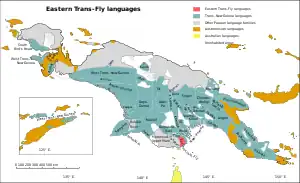Eastern Trans-Fly languages
The Eastern Trans-Fly (or Oriomo Plateau) languages are a small independent family of Papuan languages spoken in the Oriomo Plateau to the west of the Fly River in New Guinea.
| Eastern Trans-Fly | |
|---|---|
| Oriomo Plateau | |
| Geographic distribution | Oriomo Plateau, Papua New Guinea, Torres Strait Islands (Australia) |
| Linguistic classification | Trans-Fly or independent language family
|
| Glottolog | east2503 |
 Map: The Eastern Trans-Fly languages of New Guinea
The Eastern Trans-Fly languages
Trans–New Guinea languages
Other Papuan languages
Austronesian languages
Australian languages
Uninhabited | |
Classification
The languages constituted a branch of Stephen Wurm's 1970 Trans-Fly proposal, which he later incorporated into his 1975 expansion of the Trans–New Guinea family as part of a Trans-Fly – Bulaka River branch. They are retained as a family but removed from Trans–New Guinea in the classifications of Malcolm Ross and Timothy Usher.
Wurm had concluded that some of his purported Trans-Fly languages were not in the Trans–New Guinea family but rather heavily influenced by Trans–New Guinea languages. Ross (2005) removed the bulk of the languages, including Eastern Trans-Fly, from Wurm's Trans–New Guinea.
Timothy Usher links the four languages, which he calls Oriomo Plateau, to the Pahoturi languages and the Tabo language in an expanded Eastern Trans-Fly family.
Languages
Oriomo (Eastern Trans-Fly) languages and respective demographic information listed by Evans (2018) are provided below.[1] Geographical coordinates are also provided for each dialect (which are named after villages).[2]
Pronouns
The pronouns Ross reconstructs for proto–Eastern Trans-Fly are,
I *ka exclusive we *ki inclusive we *mi thou *ma you *we he/she/it *tabV; *e they *tepi
There is a possibility of a connection here to Trans–New Guinea. If the inclusive pronoun is historically a second-person form, then there would appear to be i-ablaut for the plural: *ka~ki, **ma~mi, **tapa~tapi. This is similar to the ablaut reconstructed for TNG (*na~ni, *ga~gi). Although the pronouns themselves are dissimilar, ablaut is not likely to be borrowed. On the other hand, there is some formal resemblance to Austronesian pronouns (*(a)ku I, *(ka)mu you, *kita we inc., *(ka)mi we exc., *ia he/she/it; some archeological, cultural and linguistic evidence of Austronesian contact and settlement in the area exists (David et al., 2011; McNiven et al., 2011; McNiven et al., 2006; McNiven et al., 2004: 67-68; Mitchell 1995).
Vocabulary comparison
The following basic vocabulary words for Bine (Täti dialect), Bine (Sogal dialect), Gizra (Kupere dialect) and Wipi (Dorogori dialect) are from the Trans-New Guinea database.[3] The equivalent words for Meriam Mir are also included.[4]
gloss Bine (Täti dialect) Bine (Sogal dialect) Gizra (Kupere dialect) Wipi (Dorogori dialect) Meriam Mir head mopo mopo siŋɨl mopʰ kìrìm hair ede ŋæři mopo ŋæři eřŋen mop ŋɨs mus ear tablam tablamo gublam yəkəpya girip, laip eye iřeʔu iřeku ilkʰəp yəř erkep nose keke keke siəkʰ sok pit tooth giřiʔu ziřgup tìrìg tongue wætæ wærtæ uːlitʰ vlat werut leg er̃ŋe er̃ŋe wapʰər̃ kwa teter louse ŋamwe ŋamo ŋəm bɨnɨm nem dog dřego dřeŋgo ume yɔŋg omai pig blomwe blomo b'om borom bird eře eře pʰöyɑy yi ebur egg ku ku uŕgup kʰɨp wer blood uːdi uːdi əi wɔːdž mam bone kaːke kaːko kʰus kʰakʰ lid skin tæːpwe tæːpo sopʰai gɨm gegur breast nono ŋamo ŋiam ŋɔm nano tree uli uli nugup wʉl lu(g) man řoːřie řoːřie pʰam r̃ɨga kimiar woman magebe magobe kʰoːl kʰɔŋga koskìr sun abwedži bimu abɨs lom lìm moon mřeːpwe mabye mɛlpal mobi meb water niːye niːye nai ni nì fire ulobo ulikobo uːř par̃a ur stone kula kula iŋlkʰup gli bakìr name ŋi ŋi ŋi niː nei eat waː aloda nina wavwin ero one neːteřa yepæ dər̃pʰan yəpa netat two neneni neneni niːs nɨmɔg neis
References
- Evans, Nicholas (2018). "The languages of Southern New Guinea". In Palmer, Bill (ed.). The Languages and Linguistics of the New Guinea Area: A Comprehensive Guide. The World of Linguistics. Vol. 4. Berlin: De Gruyter Mouton. pp. 641–774. ISBN 978-3-11-028642-7.
- United Nations in Papua New Guinea (2018). "Papua New Guinea Village Coordinates Lookup". Humanitarian Data Exchange. 1.31.9.
- Greenhill, Simon (2016). "TransNewGuinea.org - database of the languages of New Guinea". Retrieved 5 November 2020.
- McNiven, Ian J.; Hitchcock, Garrick (2015). "Goemulgaw Lagal: Natural and Cultural Histories of the Island of Mabuyag, Torres Strait" (PDF). Memoirs of the Queensland Museum – Culture. 8. Retrieved 18 May 2022.
- Ross, Malcolm (2005). "Pronouns as a preliminary diagnostic for grouping Papuan languages". In Andrew Pawley; Robert Attenborough; Robin Hide; Jack Golson (eds.). Papuan pasts: cultural, linguistic and biological histories of Papuan-speaking peoples. Canberra: Pacific Linguistics. pp. 15–66. ISBN 0858835622. OCLC 67292782.
- David, B., McNiven, I.J., Mitchell, R., Orr, M., Haberle, S., Brady, L. & Crouch, J. 2004. Badu 15 and the Papuan-Austronesian settlement of Torres Strait. Archeology in Oceania 39(2): 65-78.
- Fleischmann, L. and Turpeinen, S. "A Dialect Survey of Eastern Trans-Fly Languages". In Reesink, G.P., Fleischmann, L., Turpeinen, S. and Lincoln, P.C. editors, Papers in New Guinea Linguistics No. 19. A-45:39-76. Pacific Linguistics, The Australian National University, 1976. doi:10.15144/PL-A45.39
- McNiven, I.J., Dickinson, W.R., David, B., Weisler, M., Von Gnielinski, F., Carter, M., & Zoppi, U. 2006. Mask Cave: red-slipped pottery and the Australian-Papuan settlement of Zenadh Kes (Torres Strait). Archaeology in Oceania 41(2): 49-81.
- McNiven, I.J., David, B., Richards, T., Aplin, K., Asmussen, B., Mialanes, J., Leavesley, M., Faulkner, P., UlmM, S. 2011 New directions in human colonisation of the Pacific: Lapita settlement of south coast New Guinea. Australian Archaeology 72:1-6.
- Mitchell, R. 1995. Linguistic Archeology in Torres Strait. Unpublished MA thesis (James Cook University: Townsville).